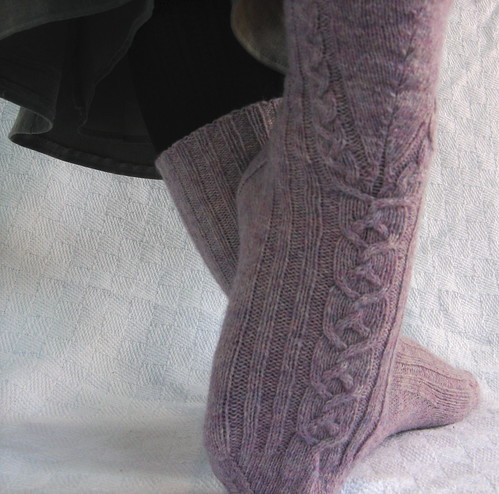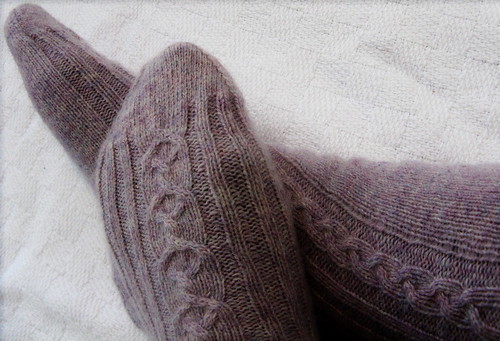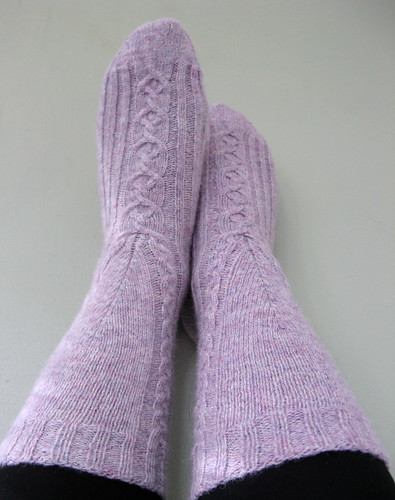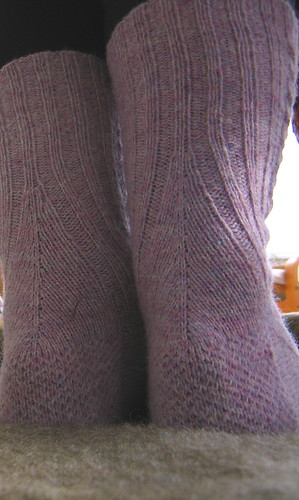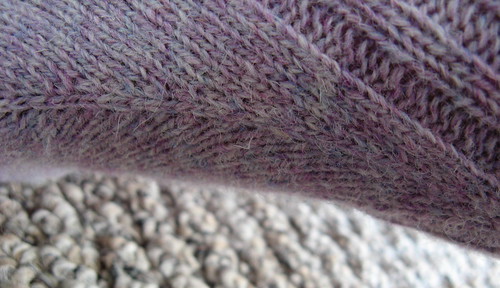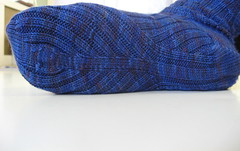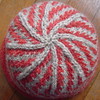contagious
Alex and I went to the desert for vacation last week, and returned sick. Really, really sick in one case. (I blame the airplane coughers, though breathing in who knows what in a dusty windstorm our first night camping couldn't have helped, either!) You certainly don't need to (or want to, I'm sure!) know the details, but needless to say, not much crafty stuff has been accomplished in the past couple of weeks.
Luckily, I have some handspun that I haven't blogged about, yet, so I can cheat my way into "new" content for a blog post. The first was an attempt at a 3 ply fingering weight yarn. It was very successful in some ways, but not at being a fingering weight:

The roving was Spunky Eclectic superwash merino in the Hyacinth colorway. The yarn is 100 grams, 227 yards, and 17 wpi (sportweight). And it's obviously pretty dense, because in numbers it has almost the same grist as Cascade 220, which is a light worsted weight!
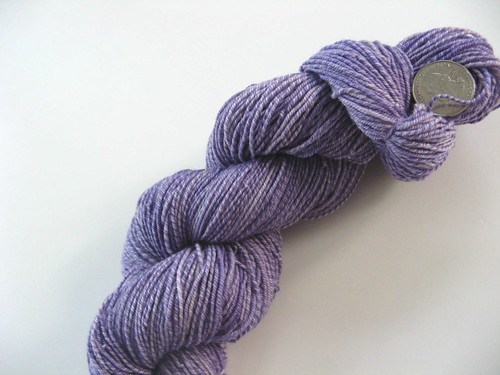
This was my first time working with superwash merino. It was a bit more fussy than non-superwash merino, and I found that it felt a bit squeaky at first. But once I got used to its flyaway nature, and figured out how to avoid the squeakiness (no advice to share, it just happened), I learned to really like this fiber. The resulting yarn is very smooth and soft, and nice and springy. I plan to work with it again soon.
My next project was also merino, and came with a lesson. That lesson is that, while I like to believe that I have a good eye for detail, I'm certainly not infallible. For a couple of months (ever since I've had my wheel, and I can't believe it hasn't been longer than that!) I filled my bobbins by moving the yarn from hook to hook up and down the right side of the flyer. There are hooks on the left side of the flyer, and I'd heard they were there to balance the flyer. Then I did some Google searches on some spinning related topic or another, and found someone mention how she loves how full she can get her Schacht bobbins because of the offset hooks on either side of the flyer. Wait... they're OFFSET? I swear, I'd even checked for that when I first got the wheel. I knew that they weren't offset. Except... they are. And when you alternate sides, you fill your bobbin a lot more evenly and efficiently. Take a look:
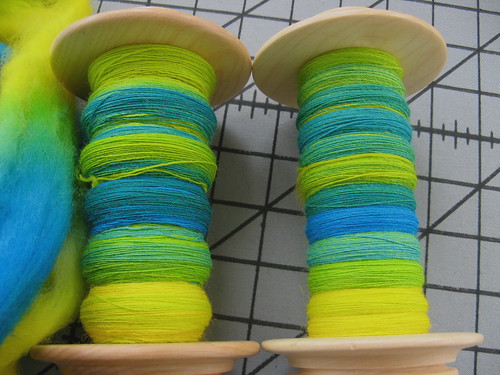
Isn't that amazing! There is no more fiber on the left bobbin than on the right. But I bet I could fit a whole lot more on the right bobbin than on the left bobbin, if I wanted. I thought I was an absolute dimwit for not realizing this earlier, and said so in the Schacht group on Ravelry. oops! I inadvertantly implied that a whole bunch of other folks were also dimwits, because there were a lot of people who hadn't realized that the hooks were offset. At least I wasn't alone!
Now, there are two ways to use the offset hooks, as far as I can tell. What you see in the above photo is a result of me using both sets of hooks on each trip up and down the flyer, if that makes sense. So I'd hook the yarn over the first hook on the right, then the first on the left, then the second on the right, then the second on the left, etc. The other way to do it is to just go up one side and down the other, filling in the gaps on the yarn's return trip down the length of the flyer. This second method is easier, in my opinion (you're less likely to lose track of where to move the yarn next). However, I think the first method looks prettier, and makes it easier to pack the bobbin as evenly and tightly as possible.
Here's the resulting yarn:
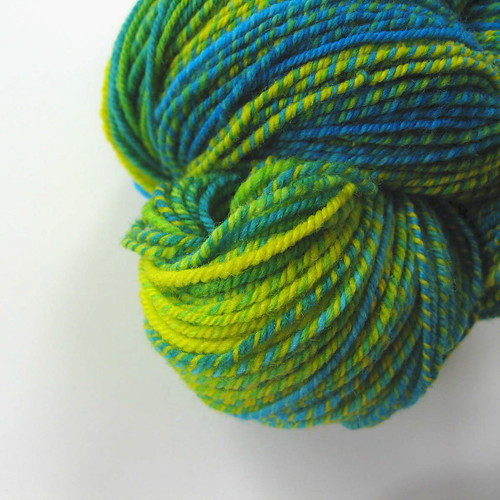
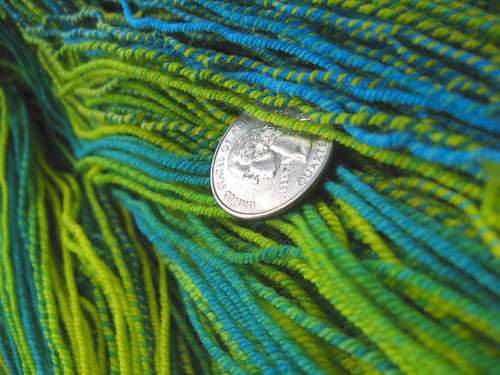
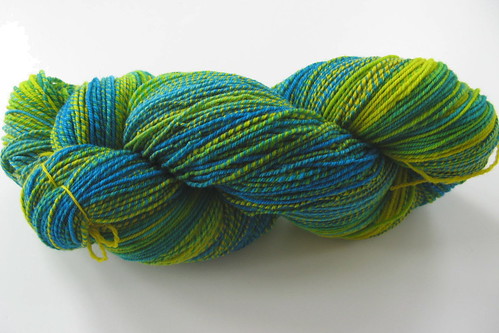
I got the merino roving (Macaw colorway) from The Arts At Eagle's Find. The yarn is a 3 ply, 120 grams, 427 yards, and 18 wpi (fingering). It's incredibly springy -- even springier than than Socks that Rock. (Beginner's luck!) I had divided the roving into 3 even strips, to try to get a yarn without a lot of marling. The first two bobbins were almost spot on, but the third one got off. It's a pretty neat effect, even if that's not exactly what I was going for. I started socks with this yarn while on vacation.
Apparently I had more to say than I initially thought! See you guys again when fiber trumps illness...
Luckily, I have some handspun that I haven't blogged about, yet, so I can cheat my way into "new" content for a blog post. The first was an attempt at a 3 ply fingering weight yarn. It was very successful in some ways, but not at being a fingering weight:

The roving was Spunky Eclectic superwash merino in the Hyacinth colorway. The yarn is 100 grams, 227 yards, and 17 wpi (sportweight). And it's obviously pretty dense, because in numbers it has almost the same grist as Cascade 220, which is a light worsted weight!

This was my first time working with superwash merino. It was a bit more fussy than non-superwash merino, and I found that it felt a bit squeaky at first. But once I got used to its flyaway nature, and figured out how to avoid the squeakiness (no advice to share, it just happened), I learned to really like this fiber. The resulting yarn is very smooth and soft, and nice and springy. I plan to work with it again soon.
My next project was also merino, and came with a lesson. That lesson is that, while I like to believe that I have a good eye for detail, I'm certainly not infallible. For a couple of months (ever since I've had my wheel, and I can't believe it hasn't been longer than that!) I filled my bobbins by moving the yarn from hook to hook up and down the right side of the flyer. There are hooks on the left side of the flyer, and I'd heard they were there to balance the flyer. Then I did some Google searches on some spinning related topic or another, and found someone mention how she loves how full she can get her Schacht bobbins because of the offset hooks on either side of the flyer. Wait... they're OFFSET? I swear, I'd even checked for that when I first got the wheel. I knew that they weren't offset. Except... they are. And when you alternate sides, you fill your bobbin a lot more evenly and efficiently. Take a look:

Isn't that amazing! There is no more fiber on the left bobbin than on the right. But I bet I could fit a whole lot more on the right bobbin than on the left bobbin, if I wanted. I thought I was an absolute dimwit for not realizing this earlier, and said so in the Schacht group on Ravelry. oops! I inadvertantly implied that a whole bunch of other folks were also dimwits, because there were a lot of people who hadn't realized that the hooks were offset. At least I wasn't alone!
Now, there are two ways to use the offset hooks, as far as I can tell. What you see in the above photo is a result of me using both sets of hooks on each trip up and down the flyer, if that makes sense. So I'd hook the yarn over the first hook on the right, then the first on the left, then the second on the right, then the second on the left, etc. The other way to do it is to just go up one side and down the other, filling in the gaps on the yarn's return trip down the length of the flyer. This second method is easier, in my opinion (you're less likely to lose track of where to move the yarn next). However, I think the first method looks prettier, and makes it easier to pack the bobbin as evenly and tightly as possible.
Here's the resulting yarn:



I got the merino roving (Macaw colorway) from The Arts At Eagle's Find. The yarn is a 3 ply, 120 grams, 427 yards, and 18 wpi (fingering). It's incredibly springy -- even springier than than Socks that Rock. (Beginner's luck!) I had divided the roving into 3 even strips, to try to get a yarn without a lot of marling. The first two bobbins were almost spot on, but the third one got off. It's a pretty neat effect, even if that's not exactly what I was going for. I started socks with this yarn while on vacation.
Apparently I had more to say than I initially thought! See you guys again when fiber trumps illness...
Labels: spinning, spinningwheel

